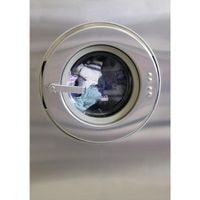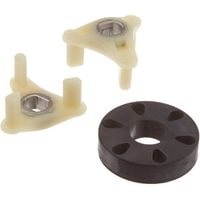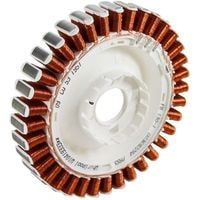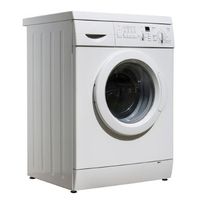Whirlpool Washer Won’t Agitate Spin or Drain. The last thing you expect when doing your washing is dirty, soaking wet clothes – of course, this is exactly what happens if your Whirlpool washer won’t agitate, spin or drain.
If your Whirlpool washer is having trouble doing these tasks, you’ll find that the drum will be filled with water and not your freshly cleaned clothes ready for the dryer.
The most likely cause in this scenario would be a clogged hose or pump, but there are many other causes such as a defective switch on the lid opening and closing mechanism.
A broken motor for spinning and draining water in the case of an agitated spin cycle malfunction, or even a busted belt because every laundry load comes with its fair share of issues.
Whirlpool Washer Won’t Agitate Spin or Drain

If your washer appears unable to drain or spin, the water level control may be faulty. Open the machine’s control panel and look for a plastic tube attached to the water level valve. If it’s clogged, clear it out with vinegar. If the valve itself is corroded, you may need to replace it by first using a screwdriver to remove its set screws.
In this article, I will describe some possible causes of a Whirlpool washer that won’t spin or drain.
Transmission Problem
There is a possibility that the washer transmission is defective. There are gears in transmissions that can fail, causing the washer to no longer spin or agitate. In most cases, this will not occur.
First and foremost, you should make sure that all other components are functioning properly before you replace the transmission.
Check that the motor turns the transmission and if it does, but the washer still does not spin and agitate, you may want to consider a new transmission.
Problem With Motor Coupling

The motor coupling connects the washer’s transmission to the motor.
If either is overloaded, the coupling will fail in order to protect both.
As normal wear and tear accumulate, so does the likelihood that it suddenly might break unexpectedly, which can present problems for people who are unaware that their machine may need evaluating for potential signs of damage.
If at all possible, have a certified technician inspect your machine if you suspect a sudden failure of parts or pieces, and give us a call so that we can help evaluate what’s wrong with your machine and ultimately offer you solutions.
Misaligned Lid Switch Assembly
The lid switch assembly on the washer is in place to prevent the wash cycle from spinning when the lid is open.
If this lid switch assembly ever stops working and commands that the lid be closed, you should know that there’s a problem with it. To determine whether or not you have an issue with your lid switch assembly.
All you need to do is test it for continuity using a digital multimeter. If your washer’s part isn’t functioning properly, then you should replace it right away before continuing to use your washing machine.
Faulty Rotor Assembly
During rotation, the rotor interacts with the stator to create a powerful electromagnetic field, which controls motor movement. It performs a mechanical task for an electrical function.
If any part of the rotor is defective, including malfunctioning components such as broken or worn-out motor brushes (the brush assembly that transfers electrical current from the stator coils to the rotor).
The washer does not spin or agitate properly. To determine if the rotor is defective, inspect it for damage and broken parts, like worn-out brushes if present.
Driving Motors Cause
The drive motor may be the problem but check for other common washing machine issues too. Sometimes there might be a smell or mold. The water supply lines may be clogged, or nozzles could be missing from the spray arms.
Make sure all of the filters are clean so that none of these contribute to your machine’s problems. If there’s suspicion that a component is faulty, like an open hose clamp or worn-out gasket, you may want to change it out as well.
To figure out if the motor is causing your pressure issues and how bad they are, first, ensure power is getting to the equipment. If your machine hums but doesn’t run fast enough, if it vibrates too much or isn’t spinning freely, you need to order a replacement.
Defective Stator Assembly

The stator interacts with the rotor to create an electromagnetic field. This allows the tub to rotate.
If either component on the stator or the rotor has faults, it may prevent the machine from spinning.
Check the stator and the rotor carefully for damage caused by wear and tear and faulty parts that are affecting rotation or speed of rotation.
Switch And Motor Assembly For Door Locks
During operation, the washer door is kept securely closed by the door. This allows the washer to begin running when the door is closed. If the washer door doesn’t stay closed, there may be a problem with the door lock assembly.
Inspect the door lock and make sure that it’s secure and in working order. If anything is damaged or doesn’t work as it should, then have it replaced right away.
For an easier way to figure out if there’s a problem with your replacement door lock assembly, use this multimeter to check how much resistance you’re getting from both of your switches inside the assembly to see if they’re passable or if one of them isn’t working quite right and needs replacing.
Control Board For Motors
The motor control board is in charge of letting the motor know what to do. If the motor control board goes out, then oftentimes the washing machine will either not function properly or will not function at all.
First off, it’s important to assure that you check both wires and hoses if they are frayed or worn in any way. Another important way to check is to make sure that the control panel has power and is communicating with other components by sending signals to the hoses that are connected as well as from there.
The best way to determine if your washing machine needs a new motor control board is by checking different wires and components on the board itself for any kind of damage such as burns or cuts in any shape or form.
Whirlpool Washer Won’t Agitate Spin or Drain
Related Guides
